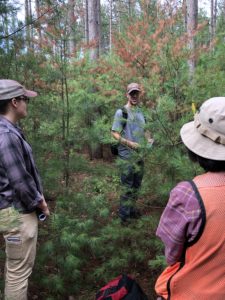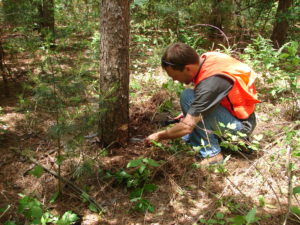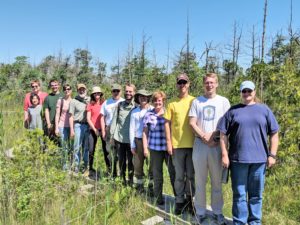By Mike Hillstrom, forest health specialist, Fitchburg, Michael.Hillstrom@wisconsin.gov, 608-513-7690
Wisconsin forests are impacted by a large variety of native and non-native insects, diseases, plants and worms. Extreme weather events like last year’s widespread blowdown incident also have significant impacts to the health of Wisconsin’s forests. The role of a forest health specialist is to assess forest damage caused by biotic and abiotic agents and provide management recommendations to return the forest to full function.

Forest health specialists discussing symptomatic red pine trees while on a site visit.
Forest health specialists are the experts that help foresters determine how to deal with outbreaks of insects, diseases and other forest health issues. “Foresters are in the woods to set up and monitor timber sales and to provide forest management advice to landowners. Forest health specialists are in the woods to diagnose why trees are dying and provide solutions,” says forest health specialist Mike Hillstrom. “We are trained insect and disease experts.” A team of six forest health specialists are spread around the state to best serve the needs of our state, county and private lands foresters and forest landowners. “We work with a range of partners at USDA Forest Service and Animal Plant Health Inspection Service, Department of Agriculture, Trade and Consumer Protection, tribes, University of Wisconsin staff around the state and forest health experts in neighboring states and beyond to track, diagnose and manage any forest health threat that arises” says Hillstrom. “Forest health specialists focus our efforts on forests of 10 or more acres. UW-Extension staff and arborists deal with individual yard trees.”
The work of a forest health specialist changes with the seasons. Late winter and spring are spent preparing for summer survey work. “As we move into summer, our team of specialists starts looking for new sites to release the parasitoid wasps that kill emerald ash borer,” says Hillstrom. Another seasonal project is looking for new and emerging pests in places where they are most likely to show up, such as beech bark disease in counties that border Lake Michigan. Most of summer is spent in the woods doing site visits to determine the causes of tree mortality.

Forest health specialist Mike Hillstrom removes bark on a red pine tree to look for signs of fungal infection.
“The work changes throughout the season and from year to year depending on weather and climate conditions. In dry years we tend to have more insect issues, and in wet years we often find more damage from diseases. And we are always helping land managers and landowners deal with emerald ash borer, oak wilt, and other high-profile tree health issues,” says Hillstrom.
Detailed data is collected about how many acres of damage each pest causes. Each forest health specialist is responsible for monitoring a zone of 8-15 counties, so data collection involves a combination of aerial and ground surveys, as well as reports from foresters and forest landowners. All this data is compiled and submitted as an annual report to Forest Service in the fall of each year.
As site visits and reporting requirements slow in late fall, forest health specialists gear up for the season of meetings and presentations. “It’s extremely important to share information with our partners and impacted forest landowners,” says Hillstrom, explaining that presentations are given around the state to keep interested parties in the loop with current forest health issues and research. Winter is also the time to update factsheets and web content, learn about new pests, develop new skills and plan for the next field season.
One critical task that falls to the forest health team is to help with the development of management guidelines. “We work closely with our partners and the forest industry to determine if guidelines are necessary and what they should include,” says Hillstrom. Guidelines are currently recommended for management of oak wilt, Heterobasidion root disease and emerald ash borer.

The forest health team, including forest health specialists and statewide staff, a team field visit in 2018.
Hillstrom notes “Being a forest health specialist is a lot of fun. We get to spend time working in the woods and interacting with other forestry professionals and members of the public. But not every day is perfect. Biting insects, poison ivy, plants with spines, and rapidly changing weather try to ruin the experience some days. If you can handle standing in a flooded lowland forest and fending off attacks from mosquitoes and deerflies, you may enjoy being a forest health specialist in Wisconsin. But if that’s your idea of a nightmare, then this job may not be for you.”
#NASF100
